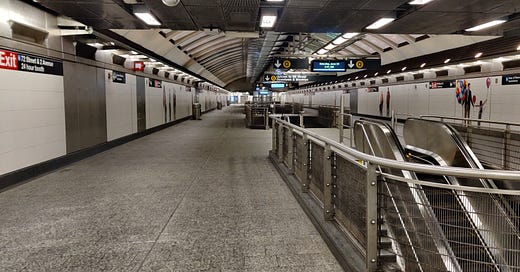Proposing public transit advocacy as an EA cause area
Advocacy to reduce transit costs could be important, neglected, and tractable—and competitive with land use reform

Hi everyone! I wrote this essay as an EA Forum post proposing advocacy to reduce public transit construction costs as an important, neglected, and tractable cause area. Open Philanthropy, the largest philanthropic foundation in the EA movement, already makes a lot of grants to support pro-housing advocacy, and I’m encouraged to see how successful their grantmaking has been to date. Housing and public transit complement each other in cities, and public transit advocacy could amplify the economic gains from housing growth in the United States by a factor of 7-9.
I can’t promise that I’ll post even remotely regularly on this blog, but I’m interested in writing more about the NYC subway and this felt like a good place to start.
All original content on this blog is now licensed under Creative Commons Attribution 4.0 International. This change was inspired by the EA Forum’s 2022 policy announcement.
Land use reform is currently a cause area funded by Open Philanthropy. However, promoting housing production alone will yield limited economic growth, as a lot of the gains would be offset by harms from increased traffic congestion. Reforms are also needed to enable cities to build out rapid transit networks so they can support the resulting population growth.
According to the Transit Costs Project, “solely building more housing in congested, high-demand cities like New York and San Francisco carries a benefit of 1.4% of GDP,” whereas building both housing and rapid transit would grow the U.S. economy by 10-13% ($2.5-$3.3 billion per year), or 7-9x what housing alone would yield.1
The main obstacle to rapid transit expansion in these cities is the exorbitant construction costs. For example, it can cost upwards of $2 billion per kilometer ($3.3 billion per mile) to build a subway line extension in NYC, whereas other cities across the U.S. (like Boston) and in other countries (like Istanbul and Barcelona) regularly build subway lines for less than $360 million per kilometer.2 The high-cost environment makes it difficult for transit agencies to justify and secure funding for new construction projects. For example, the New York MTA recently had to suspend construction on the Second Avenue Subway because congestion pricing has been paused and it was relying on that $1 billion/year funding stream.3
The cost issue is especially acute in NYC but is by no means limited to it. Other cities like London, Hong Kong, and San Francisco are also affected by high costs.4
TCP has proposed a raft of strategies that transit agencies in high-cost environments can use to get their costs down. These strategies include building up transit agencies’ in-house expertise and capacity, especially their capacity to review designs; promoting standard design systems for stations; discouraging overbuilding (such as station caverns that are 2x longer than the stations themselves); and promoting information sharing among infrastructure agencies and the public.5
The problem is there are very few organized groups advocating for this. There are the Transit Costs Project and the Effective Transit Alliance in NYC. But at least within NYC, most public transit advocacy organizations don’t really focus on getting construction costs under control. Meanwhile, the debate about congestion pricing in NYC (where I’m from) has been highly polarized, with opponents citing the MTA’s inefficiency as a reason not to give it additional funding. Tackling construction costs could help bring proponents and skeptics of public transit together by enabling transit agencies to deliver more value for each dollar paid by taxpayers.
Other than this, I would expect the political tractability of transit expansion to be similar to that of building more housing. NIMBYism is an obstacle to transit as well as housing, and the coalition in favor of public transit expansion is a bit broader as it includes more of the progressive left.
Goldwyn, Levy, Ensari, and Chitti (2023). “Transit Costs Project: Executive Summary.”
Einiger (2024). “MTA stops construction on Second Avenue subway amid congestion pricing pause.” ABC7 New York.
Goldwyn, Levy, Ensari, and Chitti (2023). “Transit Costs Project: Executive Summary.”




What about bike infrastructure? It's cheaper, better for the environment (in most cases), has health benefits for the riders, is the form of land-transport that makes riders the most happy (excluding walking), and is easier to implement (requires less studies/paperwork/land acquisition).